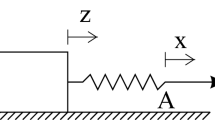Abstract
A new approach to constructing hysteretic operator (HO) is proposed in this paper. Based on the HO, the input space of neural networks is expanded from one-dimension to two-dimension and the multi-value mapping of hysteresis is transformed into a continuous mapping comprised of one-to-one mapping and multiple-to-one mapping. Based on the expanded input space, a neural network is employed to approximate hysteresis. The results of experimental examples suggest the proposed approach is effective.











Similar content being viewed by others
References
D.A. Ochoa, R. Perez, J.E. Garcia, Preisach modeling of nonlinear response in electrically biased zirconate titanate-based piezoceramics. Appl. Phys. 112(4), 1081–1088 (2013)
Q.Q. Fang, W.N. Wang, J.G. Li et al., The room-temperature ferromagnetism of defect-rich ZnMgO semiconductor thin films. Appl. Phys. 108(4), 871–876 (2012)
X. Zhao, Y. Tan, Modeling hysteresis and its inverse model using neural networks based on expanded input space method. IEEE Trans. Control Syst. Technol. 16(3), 484–490 (2008)
A. Sutor, S. Bi, R. Lerch, Validation of the rotational vector Preisach model with measurements and simulations of vectorial minor loops. Appl. Phys. 112(2), 269–273 (2013)
A. Sutor, S.J. Rupitsch, R. Lerch, A Preisach-based hysteresis model for magnetic and ferroelectric hysteresis. Appl. Phys. 100(2), 425–430 (2010)
L. Ma, Y. Tan, Y. Chu, Improved EHM-based NN hysteresis model. Sens. Actuators A Phys. 141(1), 6–12 (2008)
J.D. Wei, C.T. Sun, Constructing hysteretic memory in neural networks. IEEE Trans. Syst. Man Cybern. 30(4), 601–609 (2000)
Z. Tong, Y. Tan, X. Zeng, Modeling hysteresis using hybrid method of continuous transformation and neural networks. Sens. Actuators A Phys. 119(1), 254–262 (2005)
R.B. Gorbert, Control of Hysteretic System with Preisach Representation, Ph.D. Thesis, University of Waterloo, Ontario, 1997
K. Funahashi, On the approximate realization of continuous mappings by neural networks. Neural Netw. 2(3), 183–192 (1989)
Acknowledgments
This work is partially supported by the Zhejiang Provincial Natural Science Foundation (Grant No. Y1110508), the Interdisciplinary Pre-research Project of Zhejiang University of Science & Technology (Grant No. 2011JC03Y), Science Technology Department of Zhejiang Province (Grant No. 2014C31020) and National Natural Science Foundation of China (Grant No. 11304282).
Author information
Authors and Affiliations
Corresponding author
Rights and permissions
About this article
Cite this article
Ma, L., Shen, Y. A neural model of hysteresis in amorphous materials and piezoelectric materials. Appl. Phys. A 116, 715–722 (2014). https://doi.org/10.1007/s00339-014-8528-7
Received:
Accepted:
Published:
Issue Date:
DOI: https://doi.org/10.1007/s00339-014-8528-7




